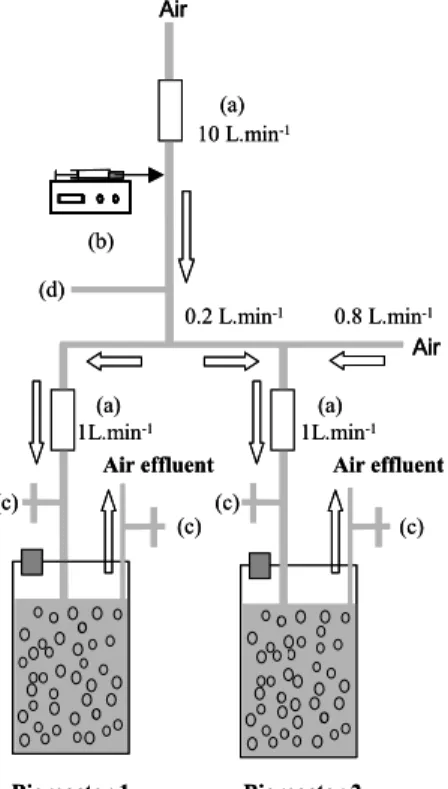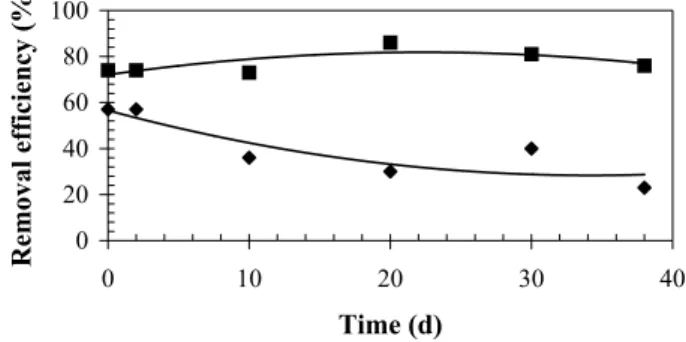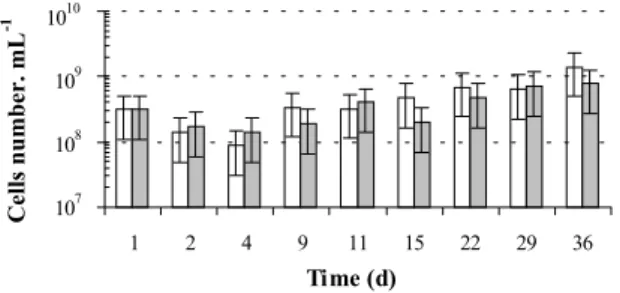TítuloBiological treatment of VOC's: impact of the volumetric load on the seelction of efficient microbial communities
Texto completo
(2) 40. L. MALHAUTIER, S. BAYLE, V. DEGRANGE, J.-J. GODON, J.-L. FANLO. functions. It appears interesting to consider more accurately the selection of the efficient microbial communities. It is a crucial step which determines the elimination efficiency level and the reactivity of the bioreactors following the modifications of the gaseous effluent composition. This step concerns the activated sludge acclimatization to the VOCs mixture. It may be realized according to an empiric manner and consists on supplying a reactor containing activated sludge with the VOCs mixture. The growth of micro-organisms colonizing activated sludge and able to metabolize pollutants is then favored. Does this enrichment step involve a loss of microorganisms diversity? Does this loss depend on the concentration of each compound introduced in the reactor? Then, the aim of this work is to evaluate the impact of the applied volumetric load on this acclimatization phase. Two reactors were used and were supplied with a gaseous effluent containing a complex mixture of eleven VOCs for which the concentration differs. The microbial communities were monitored according to the following parameters: pollutant elimination efficiency, bacterial density and the structure of the microbial communities. The structure of bacterial communities has been approached by using the Single Strand Conformation Polymorphism (SSCP) method that is based on an electrophoretic mobility shift due to a conformational change of single strand DNA under non-denaturing conditions (Orita et al., 1989). This technique has been adapted to study the bacterial diversity of ecosystems by the amplification of the 16S rDNA part (Lee et al., 1996; Schwieger and Tebbe, 1998). The dynamics of Bacteria or Archea communities in complex ecosystems as anaerobic reactors (Delbes et al., 2000; Zumstein et al., 2000), biofilms (Khammar et al., 2005), or soil (Schwieger and Tebbe, 1998; Schmalenberger et al., 2001) have been investigated. 2 MATERIALS AND METHODS 2.1 The VOC Mixture Close to industrial realities, a wide range of VOCs produced during various industrial facilities was used. The mixture of VOCs contained 11 compounds divided in respectively oxygenated compounds with methanol, acetone, methyl ethyl ketone (MEK), methyl isobutyl ketone (MIBK), butyl and ethyl acetates (BA, EA), aromatic compounds with toluene, ethylbenzene, p-xylene and halogenated compounds with dichloromethane (DCM) and 1,2-dichloroethane (DCE) (Carlo Erba Reagenti, 99% puro). The pollutants mixture was prepared by mixing equal masses of the above VOCs. 2.2 Reactor design Figure 1 shows the pilot scale units used in this study. Each unit consisted of a glass reactor. The liquid VOCs mixture was continuously injected and vaporized into an air stream operating at 10 L.min-1 via a Precidor syringe pump (Infors AG, Switzerland). Some of the polluted air (1L.min-1) was forced through a 5 L reactor seeded with 4 L of activated sludge sampled from the domestic sewage treatment plant of Saint Christol lez Alès (France). The composition of the activated sludge was 4.5g of chemical demand/liter, 1.1 g of biological oxygen demand/liter, and 5.2 g of Total suspended solids/liter. The volume of sludge was maintained constant by the regular addition of a mineral salt nutriment solution HCMM3 defined by Juteau et al. (1999). The experiment was performed at normal room temperature (20-25°C) and neutral pH was maintained using a NaOH solution (1M)..
(3) BIOLOGICAL TREATMENT OF VOCS: IMPACT OF THE VOLUMETRIC LOAD ON THE SELECTION OF E. M. C.. 41. $LU. (a) 10 L.min-1. (b) (d) 0.2 L.min-1. (a) 1L.min-1 Air effluent (c). Bioreactor 1. (c). 0.8 L.min-1 $LU (a) 1L.min-1 Air effluent. (c). (c). Bioreactor 2. Figure 1. Pilot scale units. (a) : flow rate regulators; (b) : syringe pump loaded with the mixture of 11 VOCs; (c) : gas sampling; (d): gas split.. The concentration of each compound in the inlet gas stream was 700 and 140 mg.m-3 for reactors 1 and 2 respectively. The applied volumetric loads were then 115.5 and 23.1 g VOCs.h-1.m-3 activated sludge for bioreactors 1 and 2 respectively. Both reactors have been monitored for 38 days. 2.3 Biodegradation Monitoring The biodegradation of VOCs was measured daily by monitoring the concentration of each compound at the sampling inlets and outlets. The reactor sampling points were directly connected, via Teflon tubes, to a gas chromatograph unit (HP 6890, Hewlett Packard) equipped with a flame ionization detector. The analysis conditions are summarized in Table 1. The biodegradation was monitored by calculating the VOCs removal efficiency (RE). The error in the VOCs concentration measurement was evaluated using an empty reactor. The pollutant concentration was determined 9 times, enabling the Relative Standard Deviation (RSD) to be estimated at 10%. 2.4 Bacterial Enumeration Bacteria were enumerated by fluorescence microscopy using staining with DAPI (4’,6diamidino-2-phenylindole, Sigma, USA) to determine the total bacteria number (Kepner and Pratt, 1994)..
(4) 42. L. MALHAUTIER, S. BAYLE, V. DEGRANGE, J.-J. GODON, J.-L. FANLO. Table 1. Chromatographic conditions. Injector Oven and chromatographic column Detector Temperature: 220°C Temperature: 150°C Temperature Ramp: 40°C 90°C 150°C 1 min 15°C.min-1 4 min 10°C.min-1 Air flow rate: 310 mL.min-1 H2 flow rate: 46.5 mL.min-1 Column HP-1 (polydimethylsiloxane) He flow rate: 30 mL.min-1 He flow rate (carrier gas) : 2,5 mL. min-1. A volume of sample (2 mL) was diluted in 9 volumes of 1% sodium hexametaphosphate, and homogenized with a blender (Ultra Turax, T25 basic, IKA) during 2 min at 19000 revolutions per min. Then, 1mL of this suspension was incubated with 3.7% formaldehyde during 30 min, before counter- staining by DAPI at a final concentration of 20 µg.mL-1 during 1 h, in the dark, at an agitation of 200 rpm. Stained bacteria were recovered on 0.2 µm-polycarbonate membrane filter (Millipore GTBP, Ireland) by microfiltration. The filters were then mounted on microscope slides in Mounting Medium (Sigma, USA) and observed using an epifluorescence microscope (DMLB, Leica, Germany) equipped with a blue excitation filter (BP 340 – 380 nm) and an LP 425barrier filter. For each slide, 30 fields were counted. The ability of the data was expressed in term of Relative Standard Deviation (RSD). 2.5 Analysis of total DNA by PCR-SSCP The DNA extraction method has previously been described (Godon et al., 1997). The target DNA amplified was the V3 region of the 16S rDNA gene for the bacteria domain (primers W104 and W049) (Table 2). Primer W104 was labeled by a 6-FAM fluorochrome. Each reaction tube contained 100 ng of each primer, 10 mM dNTPs, 1X Pfu Turbo DNA polymerase reaction buffer with 25 mM MgCl2, 1.25 U Pfu Turbo DNA polymerase (Stratagene) and 1 µL of purified template DNA adjusted to a total volume of 50 µL. Table 2. Primers used to amplify the 16S rDNA and their characteristics.* positions were defined by the E. coli sequence. Name Sequence Position* W104 5’-6-Fam -TTACCGCGGCTGCTGGCAC-3’ R533 W049 5’-ACGGTCCAGACTCCTACGGG-3’ F331. The reaction mixtures were placed in a thermocycler (Perkin Elmer) at 94°C for 30 s. Three-stage cycles were then performed 30 times: at 94°C for 30 s, at 61°C for W104/W49 for 30 s, 72°C for 30 s, and a final stage at 72°C for 15 min. The PCR products were diluted depending on the band intensity on the 2% agarose gel. A 1 µL of diluted PCR products was mixed with 18.8 µL of loading buffer TSR (Applied Biosystem) and 0.2 µL of internal weight standard Genescan-400 HD Rox (Applied Biosystem). The double-strand helix was then separated for 2 min at 94°C, and immediately cooled in an ice-water bath for 10 min, ensuring that single-stranded products were obtained. Capillary electrophoresis S.S.C.P analysis was performed on an ABI PRISM 310 automated DNA sequencer (Applied Biosystem) equipped with a capillary tube filled with a polymer, for 30 min at 12 KV and a 32°C temperature. A sample volume of 5 µL was loaded onto the polymer [Genescan polymer (7% w/w) at 8 mg.mL-1, Glycerol 10%, TBE 1X]. The SSCP profiles were compared after alignment with the internal weight standard..
(5) BIOLOGICAL TREATMENT OF VOCS: IMPACT OF THE VOLUMETRIC LOAD ON THE SELECTION OF E. M. C.. 43. The analysis of SSCP profiles is realized in a first time by visual comparison, then by using the SSCP2 software developed in the Environmental Biotechnology Laboratory. This software determines and aligns peaks; so co-migrated peaks were recognized. 3 RESULTS AND DISCUSSION Two parallel bioreactors, 1 and 2, which were inoculated with activated sludge from an urban wastewater treatment plant, were designed to run under identical operating conditions (Figure 1). Each reactor was supplied with a complex synthetic gaseous effluent containing oxygenated, aromatic and chlorinated compounds but the concentration differed. The concentration of each pollutant was 700 mg.m-3 and 140 mg.m-3 for bioreactor 1 and 2 respectively. Pollutant removal, dynamics of microbial densities and microbial diversity were monitored in function of time.. Removal efficiency (%). 3.1 Pollutant removal for bioreactors 1 and 2 Figure 2 presents the VOCs removal efficiencies, expressed in percentages, for both bioreactors 1 and 2. 100 80 60 40 20 0 0. 10. 20. 30. 40. Time (d) Figure 2. Removal of VOCs for both bioreactors as a function of time. Bioreactor 2, polynomial curve (order 2).. Bioreactor 1,. For bioreactor 1, The removal efficiency measured decreased from 60% to30% at t = 26 day. The abatement remained stable until t = 38 day. For bioreactor 2, the removal efficiency remained close to 80% from the beginning to t = 38 day. Table 3 presents the removal efficiencies obtained for oxygenated, aromatic and chlorinated compounds for both bioreactors. Table 3. Elimination efficiency (%) reached for VOCs chemical groups. NR: Not Removed. Compounds Bioreactor 1 Bioreactor 2 Oxygenated 45 100 Aromatic NR 55 Chlorinated NR 50. For bioreactor 1, the oxygenated compounds were removed and the elimination efficiency reached 45% while for bioreactor 2, oxygenated compounds were completely eliminated and the abatement of aromatics and halogenated compounds reached 55 and 50% respectively. All members of each family behaved similarly for bioreactor 2. For bioreactor 1, the esters were completely removed while the abatement of MEK, methanol, and acetone.
(6) 44. L. MALHAUTIER, S. BAYLE, V. DEGRANGE, J.-J. GODON, J.-L. FANLO. and MIBK decreased from values close to 100% at the beginning of the experiment to 30%, 25% and 0% respectively at t = 38 day. These results seems to highlight a negative correlation according to the microflora functioning. A better elimination efficiency is reached when the bioreactor was acclimatized with the complex VOCs mixture at low concentration. Moreover, different chemical families of compounds are removed. 3.2 Quantitative Microbial Dynamics The colonization dynamics were monitored as a function of time for 38 days (Figure 3). The results obtained by enumerating total bacteria stained with DAPI show that the bacterial densities followed the same evolution. The number of total bacteria reached at t = 36 day remains similar: 1.4 109 and 7.7 108 cells.mL-1 for bioreactor 1 and 2 respectively. Cells number. mL. -1. 10. 10. 9. 10. 8. 10. 7. 10. 1. 2. 4. 9. 11. 15. 22. 29. 36. Time (d). Figure 3. Colonisation dynamics for both bioreactors.. Bioreactor 1;. Bioreactor 2.. The applied volumetric load seems to have an impact on the removal of compounds in terms of elimination efficiency and chemical nature of the biodegraded chemicals without having an influence on the densities of the total bacterial community. 3.3 Structure of Total Bacterial Communities The SSCP method was used to define the structure of total bacterial diversity at the dominant level in activated sludge samples collected as a function of time for both bioreactors (Figure 4). On a given SSCP pattern, each peak corresponds to a distinct 16S rDNA molecule. SSCP profile analysis at the beginning of the experiment (t = 0) reveals 25 peaks. Between t = 0 to t = 38 days, the evolution of the genetic structure differs for both bioreactors. For bioreactor 1, the SSCP analysis of total bacterial DNA extracted from samples reveals 15 dominant peaks for which 10 peaks are dominant on the left of the pattern while for bioreactor 2, the number of peaks remains stable and no dominant peak is counted. Hence, at t = 38 day, the SSCP patterns obtained for both reactors are different. A simplification of the genetic structure of the total bacterial community is then observed for bioreactor 1 supplied with the highest volumetric load. Moreover, a dominant bacterial community appears. In return, when the bioreactor was supplied with the VOCs complex mixture at low concentration, a large bacterial diversity is kept..
(7) BIOLOGICAL TREATMENT OF VOCS: IMPACT OF THE VOLUMETRIC LOAD ON THE SELECTION OF E. M. C.. Bioreactor 1. 45. Bioreactor 2 0. 9. 11. 22. 29. 36. Time (d) Figure 4. Bacterial community dynamics for bioreactors 1 and 2.. 4 CONCLUSIONS This work highlights that the applied volumetric load seems to influence the functioning and the genetic structure of the bacterial community during the acclimatization phase. - A high volumetric load seems to induce a low effective functioning in terms of elimination efficiency and chemical nature of removed compounds, and a simplification of the genetic structure of the total bacterial community with the apparition of a dominant microflora. - A low volumetric load seems to favour a more efficient functioning and allows a wealther bacterial diversity to be kept. - In these biological systems treating a complex mixture of VOCs, the obtained results would show, in term of microbial ecology, that a good functioning seems to be correlated with the high level of the bacterial diversity and the absence of a dominant bacterial community..
(8) 46. L. MALHAUTIER, S. BAYLE, V. DEGRANGE, J.-J. GODON, J.-L. FANLO. 5 REFERENCES Delbes, C., Moletta, R. and Godon, J.J. (2000) Monitoring of activity of an anaerobic digestor bacterial community using a 16 rRNA polymerase chain reaction - Single- StrandConformation Polymorphism analysis (SSCP). Environ. Microbiol. 2: 506-515. Godon, J.-J., Zumstein, E., Dabert, P., Habouzit, F. and Moletta, R. (1997) Molecular microbial diversity of an anaerobic digestor as determined by small-subunit rDNA sequence analysis. Appl. Environ. Microbiol. 63: 2802-2813. Juteau, P., Larocque, R., Rho, D. and Laduy, A. (1999) Analysis of the relative abundance of different types of bacteria capable of toluene degradation in a compost biofilter. Appl. Microbiol. Biotechnol. 52: 863-868. Kepner, R.L.J. and Pratt, J.R. (1994) Use of fluorochromes for direct enumeration of total bacteria in environmental samples: past and present. Microbiol. Rev. 58: 603-615. Khammar, N., Malhautier, L., Degrange, V., Lensi, R., Godon, J.J. and Fanlo, J.L. (2005) Link between spatial structure of microbial communities and degradation of a complex mixture of volatile organic compounds in peat biofilters. J. Appl. Microbiol. 98: 476-490. Lee, D.G., Zo, Y.G. and Kim, S.J. (1996) Non radioactive method to study genetic profiles of natural bacterial communities by PCR-Single- Strand- Conformation polymorphism. Appl. Environ. Microbiol. 62: 3112-3120. Orita, M., Iwahana, H., Kanazawa, H., Hayashi, K. and Sekiya, T. (1989) Detection of polymorphisms of human DNA by gel electrophoresis as single-strand conformation polymorphisms. Proc. Natl. Acad. Sci. USA. 86: 2766-2770. Schmalenberger, A., Schwieger, F. and Tebbe, C.C. (2001) Effect of primers hybridizing to different evolutionarily conserved regions of the small-subunit rRNA gene in PCR-based microbial community analyses and genetic profiling. Appl. Environ. Microbiol. 67: 35573563. Schwieger, F. and Tebbe, C.C. (1998) A new approach to utilize PCR- Single- StrandConformation- Polymorphism for 16S rRNA gene based microbial community analysis. Appl. Environ. Microbiol. 64: 4870-4876. Zumstein, E., Moletta, R. and Godon, J.J. (2000) Examination of two years of community dynamics in an anaerobic bioreactor using fluorescence polymerase chain reaction (PCR) single-strand conformation polymorphism analysis. Environ. Microbiol. 2: 69-78..
(9)
Figure




Documento similar
The purpose of the research project presented below is to analyze the financial management of a small municipality in the province of Teruel. The data under study has
In the preparation of this report, the Venice Commission has relied on the comments of its rapporteurs; its recently adopted Report on Respect for Democracy, Human Rights and the Rule
The draft amendments do not operate any more a distinction between different states of emergency; they repeal articles 120, 121and 122 and make it possible for the President to
H I is the incident wave height, T z is the mean wave period, Ir is the Iribarren number or surf similarity parameter, h is the water depth at the toe of the structure, Ru is the
rous artworks, such as sonorou s poetry; d) instances of nOlHu1islie music, such as sonorous activiti es with soc ial, bu t not necessarily aes thetic, funct ions. Lango
On the other hand at Alalakh Level VII and at Mari, which are the sites in the Semitic world with the closest affinities to Minoan Crete, the language used was Old Babylonian,
It is generally believed the recitation of the seven or the ten reciters of the first, second and third century of Islam are valid and the Muslims are allowed to adopt either of
From the phenomenology associated with contexts (C.1), for the statement of task T 1.1 , the future teachers use their knowledge of situations of the personal
